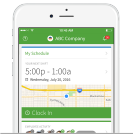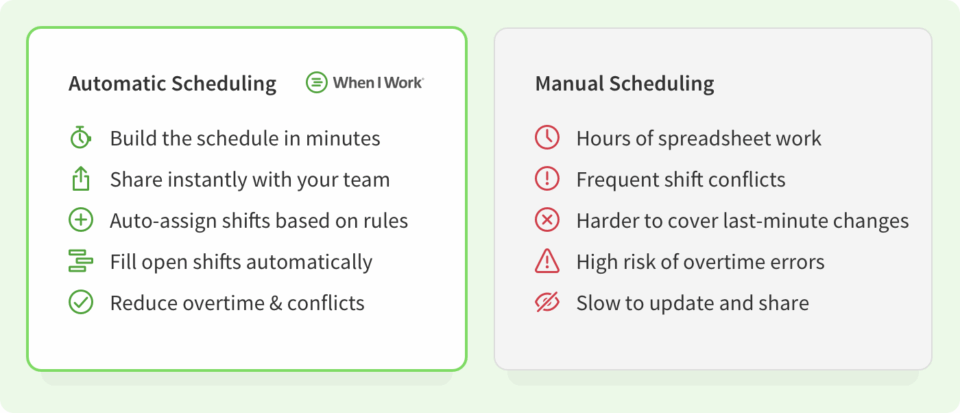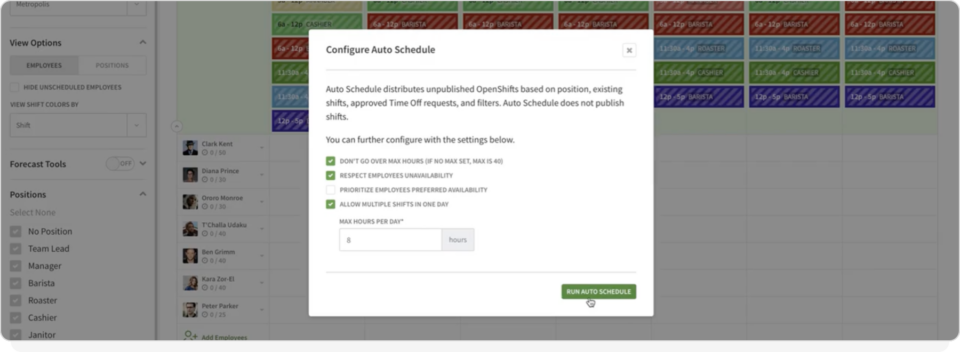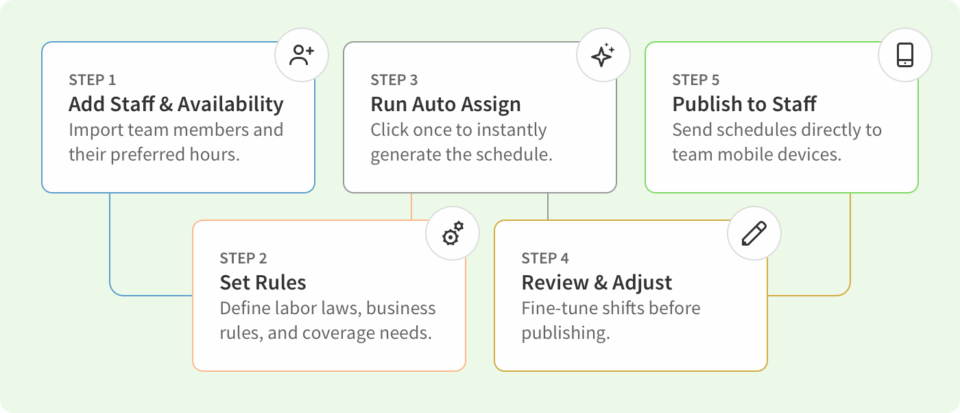Automatic Scheduling For Employees: Save Time And Cut Costs
Try When I Work for free
Tired of spending hours each week figuring out who will work…the hours each week?
Tired of having to remember what days everyone needs off? All those little notes stuffed into drawers? Random texts from a few days ago? And what happens when you forget one change and post the schedule? You’ll have to redo the entire thing and post it again, which is a hassle for you and gives your employees more of a chance to miss the updates, causing potential no-shows.
Instead of a cumbersome process full of paper, phone calls, and text messages—you can get scheduling done in one easy click with automatic scheduling. Employees can have input on when they work and get the ideal shift that they said they were interested in.
This guide will show you how to leverage an automatic scheduler for employees, its benefits, and how to choose the right solution, which can save you considerable time and effort by streamlining your scheduling process.
Here are some key things to remember about automatic scheduling:
- Automatic scheduling can cut your time spent on creating employee shift schedules by 80% and reduce labor spending by 3%.
- Using Auto Scheduling from When I Work can assist in maintaining legal compliance with predictive scheduling laws, ensuring work schedules are communicated well in advance.
- The When I Work Auto Assign feature considers elements like an employee’s trained positions, availability, and approved time-off requests when assigning shifts.
Looking to learn more about Auto Scheduling? You’re in the right spot! Keep reading or watch our video for the complete guide.
Table of contents
- What is automatic scheduling?
- How auto scheduling saves you precious time and money
- Key benefits of automatic scheduling and why it’s necessary
- What makes a great automatic scheduler?
- Choosing the right employee auto scheduler for your business
- Are you ready to put your schedule on autopilot?
- FAQs: Automatic scheduling
What is automatic scheduling?
Automatic scheduling is when you let the invisible hand of your software build the work schedule for you. You make sure you have all of the shifts you need loaded into the system. And you also make sure your employees have all of their time-off requests, availability preferences, and info like certifications and training kept updated. Then, all you have to do is click a button. The software will assign eligible employees to each shift. It’s that simple.
How auto scheduling can save you time and money
Auto scheduling can definitely make your life easier, saving you time and money. Here’s how it works:
One-click automatic scheduling
One-click automatic scheduling from When I Work reclaim hours of effort that used to be devoted to creating the work schedule. What used to take countless steps is compressed down to a single click.
With When I Work, you can enter various data to help generate the schedule. All you need is basic information, like employee time-off requests, shift preferences, and eligibility (required experience or training). Then you just enter in the shifts you need covered and When I Work will do the rest.
The When I Work Auto Assign feature
Auto Assign takes into account several key elements when assigning an employee to a shift. These include:
- The positions the employee is trained to work (tagged positions).
- Whether the employee is already scheduled for an unpublished or published shift.
- The days or shifts the employee has noted as preferring to be unavailable.
- The employee’s approved time-off requests.
- The maximum number of hours set in the employee’s profile.
These are things you would have to manually account for when scheduling, but Auto Assign does this automatically.
How Auto Assign works
Auto Assign is simple to use.
- Add your employees into When I Work.
- They request time off and input their work availability.
- You create unpublished OpenShifts for each of the positions you need covered.
- Click the Auto Assign button. When I Work automatically assigns those shifts to your employees, based on their availability, time off, and a maximum of 40 hours per week.
- Adjust the schedule as needed, and then click publish.
You have full automation with the ability to customize those results to suit the needs of your business. You can automatically create the optimal schedule for everyone involved. Plus, the process isn’t all on you. Your employees participate and save you from having to gather the data manually.
Start your free 14-day trial of When I Work! Click here to start scheduling your employees today.

Key benefits of automatic scheduling and why it’s necessary
The employment landscape has become more complicated in recent years due to changes in generational work expectations and legal requirements. Even without those changes, creating employee schedules has always been challenging.
An automatic scheduler is necessary for several reasons:
Save on costs, increase profits
Every opportunity to reduce the time spent on tasks is an opportunity to increase profits. By using an automatic scheduling tool, you can reduce the time spent on creating employee shift schedules by 80% and cut your labor spending by 3%.
Automatic scheduling also helps reduce overtime costs that stem from a variety of causes, including poor scheduling or under-utilizing new, competent employees. Some employers repeatedly schedule the same employees based on recent memory, familiarity, and habit. This leads to overtime costs and safety issues from fatigue that can incur additional costs due to employee turnover or accident.
Forecast labor demand and predict the future
Employers have to be nimble to maintain both profitability and staffing levels that provide customers optimal service.
Using a variety of demand signals, such as sales, foot traffic, or bookings, you can accurately predict how many people you will need working at any time. Perhaps there are seasons or weather patterns that affect customer behavior and labor demand. Additionally, you might know which employees are better at up-selling or work better under pressure—these are data points you can plug into your auto scheduler. While you can’t control the weather or major events that can affect your business, auto scheduling can help you use the data available to have your shifts covered.
Auto scheduling takes the guesswork out of building your shift structures using this data, some of which would be almost impossible for you to handle manually.
Meet legal compliance issues with an automatic scheduler
Predictive scheduling laws require employers to inform their employees of their work schedules well in advance of their scheduled shifts. While there are other aspects to the laws that include various protections from unfair work practices—like “clopening” or hiring new staff without offering shifts to current employees—the idea of these laws is that employees are aware of their work schedule ahead of time without fear of it changing at the last minute.
Predictive scheduling laws can be challenging for employers but can be an excellent way to retain employees. It makes it easier for employees to maintain their personal lives, schedule daycare, work other jobs, and balance their home life. They can make plans without worrying that they will have conflicts with a shift or that their hours will be cut at the last minute. Still, it’s yet another moving part employers must work through when creating employee schedules.
With auto scheduling, you don’t have to worry about legal compliance—it’s managed automatically. Auto scheduling can be adjusted for the laws in your area, creating a highly optimized and legally-compliant schedule every time.
Create fair and equitable schedules
Eliminate the hassle of juggling employee requests and preferences. The automatic scheduler takes various factors into account, such as employee preferences, availability, eligibility, qualifications, and skill sets, to create fair and balanced schedules that keep your workforce happy and motivated.
Get real-time updates and improve communication
You can adapt to changing business demands easily with real-time updates. An automatic scheduler can quickly handle unforeseen changes, such as shift swaps, time-off requests, and unexpected absences, reducing disruptions to ensure smoother operations.
You can also enhance internal communications and employee engagement with the automatic scheduler’s built-in messaging features. Managers can easily communicate schedule changes, updates, and important announcements directly through the platform.

What makes a great automatic scheduler?
Once you’ve done the research and you’re ready to choose, how will you know if the automatic scheduler is worth it?
It’s simple to use.
Choose an automatic scheduler that isn’t loaded down with requirements you have to set. A good one will let you simply add in the shifts you need and do all the work in the background, finding eligible and available employees.
You get value for cost.
Find an automatic scheduler that saves you time on scheduling. If you’re constantly having to redo the schedule after it’s made, that’s not helpful and you’re really just wasting money on the tool and in your time.
It integrates with your suit of tools and apps.
Integrated employee scheduling, time tracking, and team messaging is key to making sure the auto scheduler you choose actually works for you and your employees. Keeping everything together in the same platform increases engagement and productivity.
You have the ability to view the employee availability.
Make sure you’re able to see employee availability and time-off requests in whatever auto scheduler you choose, so you can be sure those requests are being honored. An auto scheduler should take availability into account when scheduling.
It reminds employees about upcoming shifts.
Select a platform that includes schedule and shift notifications, so employees know when they can choose from available shifts or see that they’ve been assigned shifts in the schedule. This will reduce no-shows and absenteeism.
Choosing the right employee auto scheduler for your business
When it comes to choosing the right automatic scheduler for your business, the devil is in the details. While there are several solutions available in the market, not all are created equal. The When I Work automatic scheduler stands out from the competition due to its exceptional features and user-friendly interface.

Intuitive interface.
The When I Work automatic scheduler boasts a simple, user-friendly interface that allows managers to effortlessly navigate through the scheduling process. With just a few clicks, you can create schedules that match your business’s unique requirements.
Customization options.
Flexibility is key, and the automatic scheduler from When I Work understands that. Tailor schedules to suit your business’s needs by setting various parameters, including preferred hours, time-off policies, and seniority preferences.
Seamless integration.
Easily integrate with existing systems, including payroll and time tracking solutions, making the transition smooth and hassle-free.
Are you ready to put your schedule on autopilot?
Investing in an automatic scheduler is a strategic move that reaps countless benefits for your business. Empower your team with an efficient, fair, and reliable scheduling solution that optimizes workforce management, boosts productivity, and drives success.

Instead of reinventing the wheel every week, you can simply copy the previous week’s schedule. That works in some situations. But if you need greater scheduling options and flexibility than reusing last week’s schedule, or you’re managing a lot of moving parts (and employee requests), automatic scheduling is best.
Think of it this way: for a business that relies on shifts, auto scheduling is putting artificial intelligence to work for you. You set up the initial rules, input minimal data, and AI does the rest—creating your optimal schedule.
Embrace the future of employee scheduling with the When I Work automatic scheduler today and experience the transformative power of automation. Get the perfect schedule in a single click when you sign up to try When I Work for free.
FAQs: Automatic scheduling
Q: What is automatic scheduling?
A: Automatic scheduling is a feature offered by some digital tools that helps employers generate work schedules for employees automatically. This is done based on various factors such as employee availability, shift preferences, and sometimes, even data like customer foot traffic and sales projections.
Q: What is the best automated scheduling system for small businesses?
When it comes to small businesses, the automatic scheduler from When I Work stands out as the ideal solution. Its user-friendly interface, customization options, and seamless integration make it a perfect fit for small-scale operations.
Q: How does automatic scheduling save time?
A: Automatic scheduling saves time by drastically reducing the manual effort needed to create work schedules. It takes into account factors such as employee availability, shift preferences, and time-off requests, which can significantly speed up the scheduling process and reduce errors.
Q: What are the benefits of automatic scheduling for a business?
A: Automatic scheduling can help businesses save on labor costs, reduce overtime, improve compliance with predictive scheduling laws, and better predict labor demand. It also offers an easier way to manage shifts, thereby boosting operational efficiency.
Q: What features should I look for in an automatic scheduler?
A: A good automatic scheduler should be simple to use, integrate with your existing tools and apps, allow you to view employee availability, and include schedule and shift notifications. It should also account for legal compliance, time-off requests, and employee availability when generating schedules.
Q: How do you set up an automatic shift schedule?
With When I Work, setting up an automatic shift schedule is a breeze. Simply input employee preferences, availability, and business requirements, and the system intelligently generates optimized schedules in minutes.
Q: How do I improve my schedule efficiency?
Use the automatic shift scheduler from When I Work to let the system generate a schedule that’s optimized for employee preference and availability in a single click. You’ll save time and know that your employees won’t have to swap and drop shifts due because they are outside of desired work hours.
Q: Can automatic scheduling help with legal compliance?
A: Yes, automatic scheduling can help with legal compliance. Specifically, it can help employers comply with predictive scheduling laws, which require work schedules to be communicated well in advance. By generating schedules automatically, employers can ensure they’re adhering to these laws and avoiding last-minute changes that might disrupt employees’ lives.
Start your free 14-day trial of When I Work! Click here to start scheduling your employees today.







